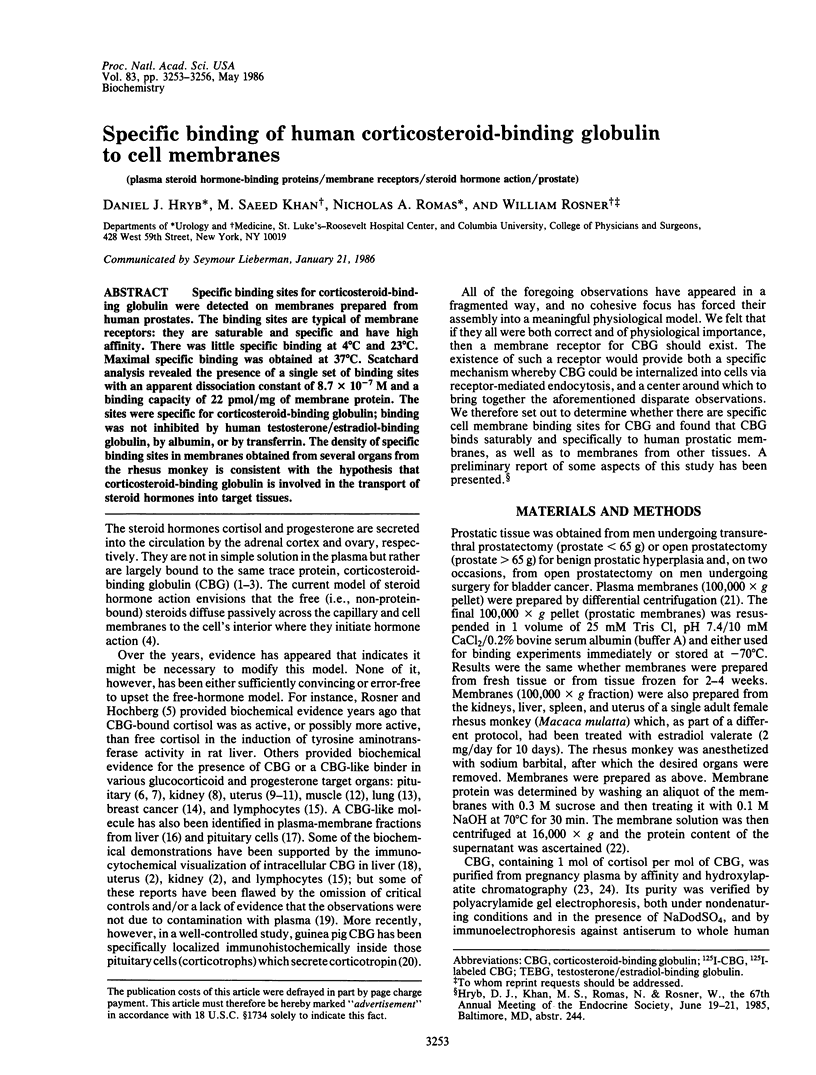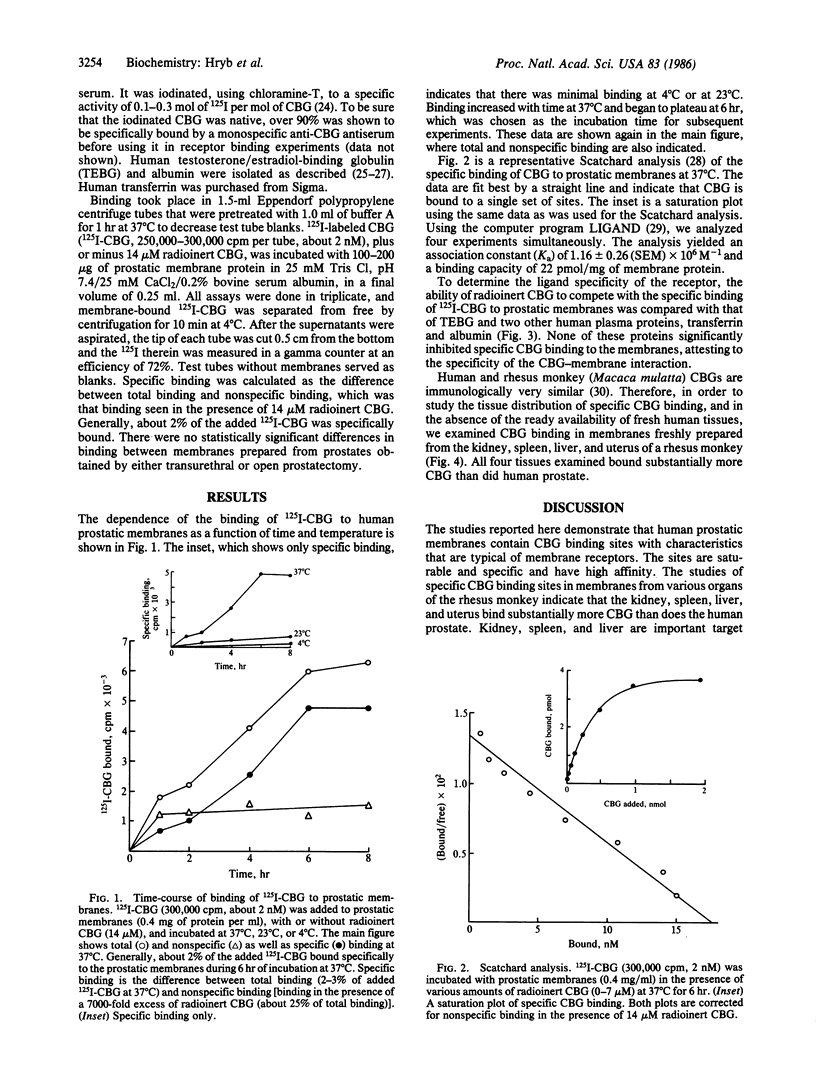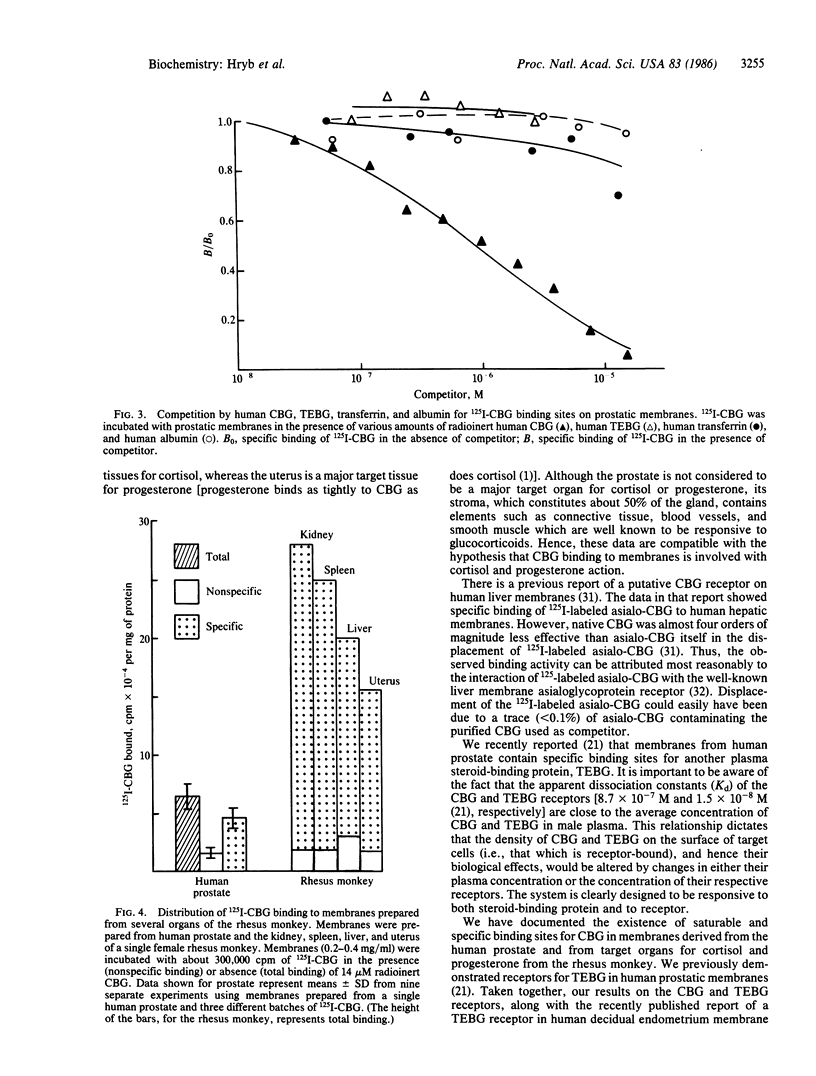Abstract
Specific binding sites for corticosteroid-binding globulin were detected on membranes prepared from human prostates. The binding sites are typical of membrane receptors: they are saturable and specific and have high affinity. There was little specific binding at 4 degrees C and 23 degrees C. Maximal specific binding was obtained at 37 degrees C. Scatchard analysis revealed the presence of a single set of binding sites with an apparent dissociation constant of 8.7 X 10(-7) M and a binding capacity of 22 pmol/mg of membrane protein. The sites were specific for corticosteroid-binding globulin; binding was not inhibited by human testosterone/estradiol-binding globulin, by albumin, or by transferrin. The density of specific binding sites in membranes obtained from several organs from the rhesus monkey is consistent with the hypothesis that corticosteroid-binding globulin is involved in the transport of steroid hormones into target tissues.
Full text
PDF



Selected References
These references are in PubMed. This may not be the complete list of references from this article.
- Al-Khouri H., Greenstein B. D. Role of corticosteroid-binding globulin in interaction of corticosterone with uterine and brain progesterone receptors. Nature. 1980 Sep 4;287(5777):58–60. doi: 10.1038/287058a0. [DOI] [PubMed] [Google Scholar]
- Amaral L., Werthamer S. Identification of breast cancer transcortin and its inhibitory role in cell-mediated immunity. Nature. 1976 Aug 12;262(5569):589–590. doi: 10.1038/262589a0. [DOI] [PubMed] [Google Scholar]
- Ashwell G., Harford J. Carbohydrate-specific receptors of the liver. Annu Rev Biochem. 1982;51:531–554. doi: 10.1146/annurev.bi.51.070182.002531. [DOI] [PubMed] [Google Scholar]
- Bordin S., Petra P. H. Immunocytochemical localization of the sex steroid-binding protein of plasma in tissues of the adult monkey Macaca nemestrina. Proc Natl Acad Sci U S A. 1980 Oct;77(10):5678–5682. doi: 10.1073/pnas.77.10.5678. [DOI] [PMC free article] [PubMed] [Google Scholar]
- De Kloet E. R., McEwen B. S. A putative glucocorticoid receptor and a transcortin-like macromolecule in pituitary cytosol. Biochim Biophys Acta. 1976 Jan 14;421(1):115–123. doi: 10.1016/0304-4165(76)90175-6. [DOI] [PubMed] [Google Scholar]
- Egloff M., Vendrely E., Tardivel-Lacombe J., Dadoune J. P., Degrelle H. Etude immunohistochimique du testicule et de l'épididyme humains à l'aide d'un antisérum monospécifique dirigé contre la protéine plasmatique liant les hormones sexuelles. C R Seances Acad Sci III. 1982 Sep 20;295(2):107–111. [PubMed] [Google Scholar]
- Faict D., De Moor P., Van Baelen H., Heyns W., Stevens E., Ceuppens J. Cortisol-free transcortin: preparation and effect on mitogen-stimulated lymphocytes. J Steroid Biochem. 1983 Oct;19(4):1397–1401. doi: 10.1016/0022-4731(83)91113-5. [DOI] [PubMed] [Google Scholar]
- Feldman D., Funder J. W., Edelman I. S. Evidence for a new class of corticosterone receptors in the rat kidney. Endocrinology. 1973 May;92(5):1429–1441. doi: 10.1210/endo-92-5-1429. [DOI] [PubMed] [Google Scholar]
- Giannopoulos G. A comparative study of receptors for natural and synthetic glucocorticoids in fetal rabbit lung. J Steroid Biochem. 1976 Aug;7:553–559. doi: 10.1016/0022-4731(76)90076-5. [DOI] [PubMed] [Google Scholar]
- Gorski J., Welshons W., Sakai D. Remodeling the estrogen receptor model. Mol Cell Endocrinol. 1984 Jun;36(1-2):11–15. doi: 10.1016/0303-7207(84)90079-0. [DOI] [PubMed] [Google Scholar]
- Hryb D. J., Khan M. S., Rosner W. Testosterone-estradiol-binding globulin binds to human prostatic cell membranes. Biochem Biophys Res Commun. 1985 Apr 16;128(1):432–440. doi: 10.1016/0006-291x(85)91697-3. [DOI] [PubMed] [Google Scholar]
- Khan M. S., Ewen E., Rosner W. Radioimmunoassay for human testosterone-estradiol-binding globulin. J Clin Endocrinol Metab. 1982 Apr;54(4):705–710. doi: 10.1210/jcem-54-4-705. [DOI] [PubMed] [Google Scholar]
- King W. J., Greene G. L. Monoclonal antibodies localize oestrogen receptor in the nuclei of target cells. Nature. 1984 Feb 23;307(5953):745–747. doi: 10.1038/307745a0. [DOI] [PubMed] [Google Scholar]
- Koch B., Lutz-Bucher B., Briaud B., Mialhe C. Specific interaction of corticosteroids with binding sites in the plasma membranes of the rat anterior pituitary gland. J Endocrinol. 1978 Nov;79(2):215–222. doi: 10.1677/joe.0.0790215. [DOI] [PubMed] [Google Scholar]
- Koch B., Lutz B., Briaud B., Mialhe C. Heterogeneity of pituitary glucocorticoid binding evidence for a transcortin-like compound. Biochim Biophys Acta. 1976 Sep 24;444(2):497–507. doi: 10.1016/0304-4165(76)90393-7. [DOI] [PubMed] [Google Scholar]
- Lan N. C., Karin M., Nguyen T., Weisz A., Birnbaum M. J., Eberhardt N. L., Baxter J. D. Mechanisms of glucocorticoid hormone action. J Steroid Biochem. 1984 Jan;20(1):77–88. doi: 10.1016/0022-4731(84)90192-4. [DOI] [PubMed] [Google Scholar]
- Mayer M., Kaiser N., Milholland R. J., Rosen F. Cortisol binding in rat skeletal muscle. J Biol Chem. 1975 Feb 25;250(4):1207–1211. [PubMed] [Google Scholar]
- McClellan M. C., West N. B., Tacha D. E., Greene G. L., Brenner R. M. Immunocytochemical localization of estrogen receptors in the macaque reproductive tract with monoclonal antiestrophilins. Endocrinology. 1984 Jun;114(6):2002–2014. doi: 10.1210/endo-114-6-2002. [DOI] [PubMed] [Google Scholar]
- Milgrom E., Atger M., Baulieu E. E. Progesterone binding plasma protein (PBP). Nature. 1970 Dec 19;228(5277):1205–1206. doi: 10.1038/2281205a0. [DOI] [PubMed] [Google Scholar]
- Munson P. J., Rodbard D. Ligand: a versatile computerized approach for characterization of ligand-binding systems. Anal Biochem. 1980 Sep 1;107(1):220–239. doi: 10.1016/0003-2697(80)90515-1. [DOI] [PubMed] [Google Scholar]
- Perrot-Applanat M., David-Ferreira J. F., David-Ferreira K. L. Immunocytochemical localization of corticosteroid-binding globulin (CBG) in guinea pig hepatocytes. Endocrinology. 1981 Nov;109(5):1625–1633. doi: 10.1210/endo-109-5-1625. [DOI] [PubMed] [Google Scholar]
- Perrot-Applanat M., Logeat F., Groyer-Picard M. T., Milgrom E. Immunocytochemical study of mammalian progesterone receptor using monoclonal antibodies. Endocrinology. 1985 Apr;116(4):1473–1484. doi: 10.1210/endo-116-4-1473. [DOI] [PubMed] [Google Scholar]
- Perrot-Applanat M., Racadot O., Milgrom E. Specific localization of plasma corticosteroid-binding globulin immunoreactivity in pituitary corticotrophs. Endocrinology. 1984 Aug;115(2):559–569. doi: 10.1210/endo-115-2-559. [DOI] [PubMed] [Google Scholar]
- Rosen V., Jung I., Baulieu E. E., Robel P. Androgen-binding proteins in human benign prostatic hypertrophy. J Clin Endocrinol Metab. 1975 Oct;41(4):761–770. doi: 10.1210/jcem-41-4-761. [DOI] [PubMed] [Google Scholar]
- Rosenthal H. E., Paul M. A., Sandberg A. A. Transcortin: a corticosteroid-binding protein of plasma. XII. Immunologic studies on transcortin in guinea-pig tissues. J Steroid Biochem. 1974 May;5(3):219–225. doi: 10.1016/0022-4731(74)90135-6. [DOI] [PubMed] [Google Scholar]
- Rosner W., Bradlow H. L. Isolation and purification of corticosteroid-binding globulin from human plasma by affinity chromatography. Methods Enzymol. 1975;36:104–109. doi: 10.1016/s0076-6879(75)36012-6. [DOI] [PubMed] [Google Scholar]
- Rosner W., Hochberg R. Corticosteroid-binding globulin in the rat: isolation and studies of its influence on cortisol action in vivo. Endocrinology. 1972 Sep;91(3):626–632. doi: 10.1210/endo-91-3-626. [DOI] [PubMed] [Google Scholar]
- Rosner W., Polimeni S., Khan M. S. Radioimmunoassay for human corticosteroid-binding globulin. Clin Chem. 1983 Jul;29(7):1389–1391. [PubMed] [Google Scholar]
- Rosner W., Pugeat M. M., Chrousos G. P., Khan M. S. Steroid-binding proteins in primate plasma. Endocrinology. 1986 Feb;118(2):513–517. doi: 10.1210/endo-118-2-513. [DOI] [PubMed] [Google Scholar]
- Rosner W., Smith R. N. Isolation and characterization of the testosterone-estradiol-binding globulin from human plasma. Use of a novel affinity column. Biochemistry. 1975 Nov 4;14(22):4813–4820. doi: 10.1021/bi00693a006. [DOI] [PubMed] [Google Scholar]
- SMITHIES O. Zone electrophoresis in starch gels: group variations in the serum proteins of normal human adults. Biochem J. 1955 Dec;61(4):629–641. doi: 10.1042/bj0610629. [DOI] [PMC free article] [PubMed] [Google Scholar]
- Siiteri P. K., Murai J. T., Hammond G. L., Nisker J. A., Raymoure W. J., Kuhn R. W. The serum transport of steroid hormones. Recent Prog Horm Res. 1982;38:457–510. doi: 10.1016/b978-0-12-571138-8.50016-0. [DOI] [PubMed] [Google Scholar]
- Silverstein S. C., Steinman R. M., Cohn Z. A. Endocytosis. Annu Rev Biochem. 1977;46:669–722. doi: 10.1146/annurev.bi.46.070177.003321. [DOI] [PubMed] [Google Scholar]
- Steins P., Krieg M., Hollmann H. J., Voigt K. D. In vitro studies of testosterone and 5alpha-dihydrotestosterone binding in benign prostatic hypertrophy. Acta Endocrinol (Copenh) 1974 Apr;75(4):773–784. doi: 10.1530/acta.0.0750773. [DOI] [PubMed] [Google Scholar]
- Strel'chyonok O. A., Avvakumov G. V. Evidence for the presence of specific binding sites for transcortin in human liver plasma membranes. Biochim Biophys Acta. 1983 Feb 22;755(3):514–517. doi: 10.1016/0304-4165(83)90257-x. [DOI] [PubMed] [Google Scholar]
- Strel'chyonok O. A., Avvakumov G. V., Survilo L. I. A recognition system for sex-hormone-binding protein-estradiol complex in human decidual endometrium plasma membranes. Biochim Biophys Acta. 1984 Dec 20;802(3):459–466. doi: 10.1016/0304-4165(84)90365-9. [DOI] [PubMed] [Google Scholar]
- Suyemitsu T., Terayama H. Specific binding sites for natural glucocorticoids in plasma membranes of rat liver. Endocrinology. 1975 Jun;96(6):1499–1508. doi: 10.1210/endo-96-6-1499. [DOI] [PubMed] [Google Scholar]
- Tardivel-Lacombe J., Egloff M., Mazabraud A., Degrelle H. Immunohistochemical detection of the sex steroid-binding plasma protein in human mammary carcinoma cells. Biochem Biophys Res Commun. 1984 Jan 30;118(2):488–494. doi: 10.1016/0006-291x(84)91329-9. [DOI] [PubMed] [Google Scholar]
- WADDELL W. J. A simple ultraviolet spectrophotometric method for the determination of protein. J Lab Clin Med. 1956 Aug;48(2):311–314. [PubMed] [Google Scholar]
- Welshons W. V., Lieberman M. E., Gorski J. Nuclear localization of unoccupied oestrogen receptors. Nature. 1984 Feb 23;307(5953):747–749. doi: 10.1038/307747a0. [DOI] [PubMed] [Google Scholar]
- Werthamer S., Samuels A. J., Amaral L. Identification and partial purification of "transcortin"-like protein within human lymphocytes. J Biol Chem. 1973 Sep 25;248(18):6398–6407. [PubMed] [Google Scholar]
- Westphal U. Steroid-protein interaction: from past to present. J Steroid Biochem. 1983 Jul;19(1A):1–15. doi: 10.1016/s0022-4731(83)80002-8. [DOI] [PubMed] [Google Scholar]
- Ylikomi T., Gasc J. M., Isola J., Baulieu E. E., Tuohimaa P. Progesterone receptor in the chick bursa of fabricius: characterization and immunohistochemical localization. Endocrinology. 1985 Jul;117(1):155–160. doi: 10.1210/endo-117-1-155. [DOI] [PubMed] [Google Scholar]


